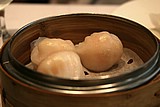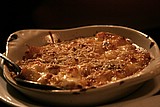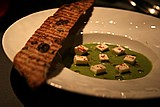Home |
Restaurants by City
|
Food Photography |
Archive | Philosophy |
![]()
Right now we are eating in Seattle, Washington.
|
Monday
2004
Permalink
|
Italy, March 11, 2004 I don't like doing anything half way. And when I'm going to have an experience that I'm really looking forward to, I really want to savor it completely. I'd rather wait awhile to do it, than do it part way now, with a promise of more later. This was the case for me when it came to going to Italy. The land, the language, and most of all the food have been calling to me all my life. And every time I have had an opportunity to go, it's either been for not very long or under circumstances that I felt wouldn't allow me to really enjoy my visit. Finally we had the opportunity to go for over a week, and decided it was time to go. There was a lot of debate about where we should go. South? North? Rome? In the end we decided to head to the region most famous for food (of course) Emilia Romagna. The thing that put me over the edge in deciding to target that region is that it's home to three of Italy's most perfect food: Parmigiano Reggiano from Parma and Reggio Emilia, Prosciutto di Parma also from Parma, and Balsamic Vinegar from Modena and Reggio Emilia. The trifecta! Finally, I decided to do a little reading up on the region. I got Emilia Romagna, Flavors of Italy, Eating In Italy: A Traveler's Guide to the Hidden Gastronomic Pleasures of Northern Italy, Italian Cuisine: A Cultural History (Arts and Traditions of the Table), and Al Dente: The Adventures of a Gastronome in Italy. They helped a bit, but ultimately there's no substitute for being there. We flew through Amsterdam so we could have a little mini-vacation on the way back. What follows is over 20 entries spanning our trip from Rome through Florence to Bologna and the countryside of Emilia Romagna. Enjoy.
|
|
Our Sponsors
Online Loans Conversion Strategies College Courses Surprise Birthdays Online Trading - Calendar and Event Schedules - Food Events and Calendars - Wine Events and Calendars - Digital Photography Resources - Jewish Gifts and Judaica - Howard Stern Podcast ponytailed blogger Jonathan Schwartz

Browse tastingmenu
Home |
Restaurants by City X |
Food Photography |
Archive | Philosophy |
![]()
Free eBooks: All About Apples
| Autumn Omakase
More:
Discussion |
Cool Food T-Shirts |
Ingredients
| Markets |
Recipes
Search |
Blog FAQ |
Other
Blogs
Best of tastingmenu
|
City View
Entry: July 6, 2006 |
Blue Plate
Entry: June 19, 2006 |
L'Atelier de Joël Robuchon
Entry: July 18, 2006 |
Browse by City
Boston | Chicago | Houston | Las Vegas | Los Angeles | Maui | New York | Philadelphia | Portland | San Francisco | Seattle | Toronto | Utah | Vancouver | Washington D.C.
Bangkok | Beijing | Hong Kong | Seoul | Tokyo
Amsterdam | Berlin | Italy | London | Madrid | Paris | Vienna
Browse by Month
2006
2005
2004
2003
2002
2001
Comments, questions, or feedback:
info / at / tastingmenu / dot / com
All pages Copyright (c) 2001-2006 tastingmenu.com
Last modified 11/27/06.



